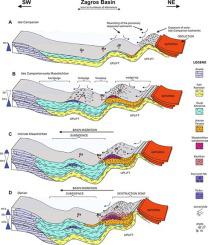Journal of Asian Earth Sciences ( IF 2.7 ) Pub Date : 2021-04-24 , DOI: 10.1016/j.jseaes.2021.104779 Mohammad J. Razmjooei , Samira Shahryari , Anoshiravan Kani , Clemens V. Ullmann , Amir Mohammad Jamali , Samira Rahimi , Jaume Vergés , Nicolas Thibault

|
In order to investigate the depositional history and facies architecture of the Campanian-Danian interval of the Zagros Basin, the succession of the Gurpi Formation (Fm.) was examined in the Gandab section, southwestern Lurestan Province, through an integrated study of calcareous nannofossils, planktic foraminifera, and bulk carbonate carbon isotopes. Despite the persistent occurrence of reworked fine fraction carbonates as attested by microfossils across the investigated interval, the carbon isotope stratigraphy of Lurestan shows a good correlation with those in the eastern and western Tethys from the Shahneshin section in central Zargos (Fars Province) and Gubbio of northern Apennines in Italy (Gubbio). The succession can be assigned an age range from late Campanian to early Danian based on the integrated stratigraphy.
The results from the Gandab section, as well as field observations in more northeasterly areas of Lurestan, point to lateral facies variation of the Campanian–Danian interval associated with tectonic activity during the Late Cretaceous-Paleogene of the Zagros Basin. According to the known distribution of facies across the SW-NE transect of Lurestan and detailed ages delineated in the Gandab section, a schematic model of syntectonic sedimentation and facies distribution is drawn. Our model illustrates how the continental convergence and closure of Neo-Tethys resulted in uplifting/subsiding of the basin floor, shifting in depocenter, significant changes in sedimentary facies, and reworking phenomena in the Lurestan region.
中文翻译:

Lurestan(伊朗扎格罗斯盆地)Campanian-Danian沉积演替的生物碳同位素综合地层:对构造相相分布和盆地演化的启示
为了调查Zagros盆地Campanian-Danian层段的沉积历史和相构造,通过综合研究石灰质纳米化石,研究了西南卢勒斯坦省Gandab段的Gurpi组(Fm。)演替,板状有孔虫和大量碳酸盐碳同位素。尽管在整个研究区间内微化石证实了返工的细碎碳酸盐的持续存在,但卢勒斯坦的碳同位素地层学与扎尔戈斯中部(Fars Province)的Shahneshin断层的特黑斯东部和西部的碳同位素地层显示出良好的相关性。意大利北部的亚平宁山脉(古比奥)。根据综合地层学,可以为该阶跃分配一个年龄范围,从Campanian晚期到Danian早期。
Gandab断面的结果以及在Lurestan的更东北的地区进行的野外观测表明,在Zagros盆地晚白垩世-古生代,Campanian-Danian间隔的侧相变化与构造活动有关。根据卢勒斯坦西南-东北横断面的已知相分布和甘达布断面描述的详细年龄,绘制了构造沉积和相分布的示意性模型。我们的模型说明了新特提斯大陆的收敛和封闭如何导致盆地底部隆升/沉降,沉积中心偏移,沉积相的显着变化以及卢勒斯坦地区的返工现象。











































 京公网安备 11010802027423号
京公网安备 11010802027423号